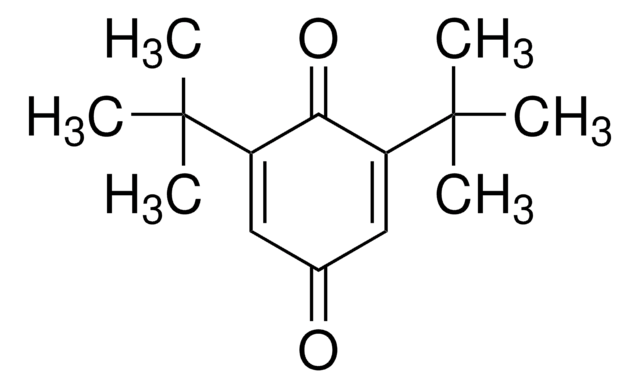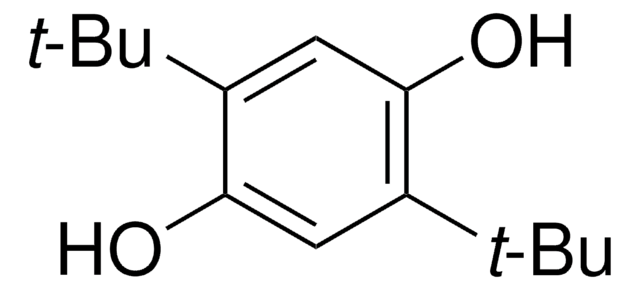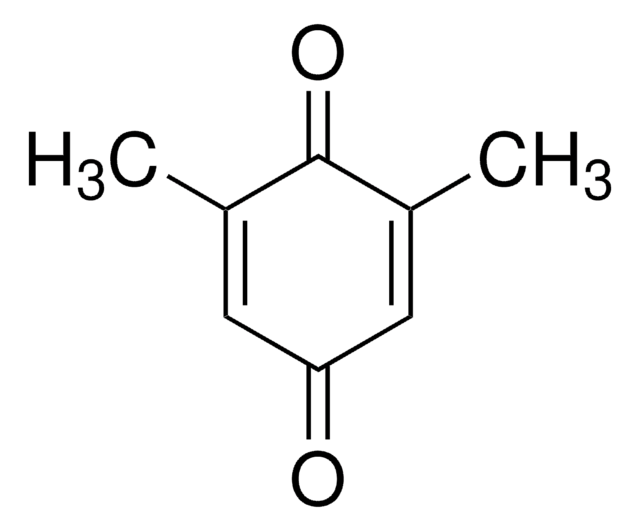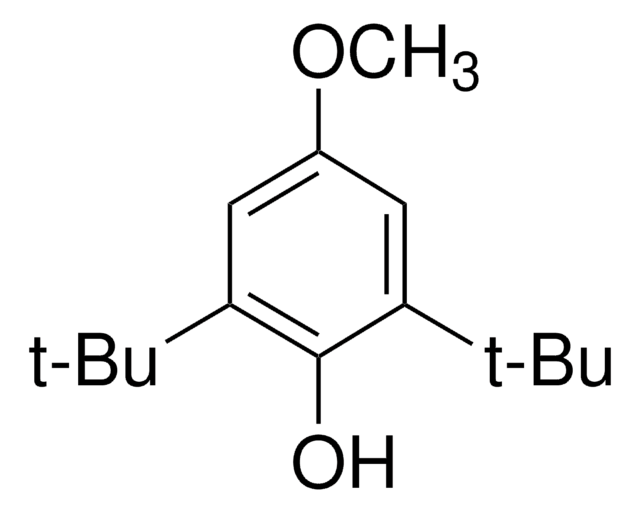419648
2,5-Di-tert-butyl-1,4-benzoquinone
99%
Se connecterpour consulter vos tarifs contractuels et ceux de votre entreprise/organisme
About This Item
Formule linéaire :
[(CH3)3C]2C6H2(=O)2
Numéro CAS:
Poids moléculaire :
220.31
Numéro CE :
Numéro MDL:
Code UNSPSC :
12352100
ID de substance PubChem :
Nomenclature NACRES :
NA.22
Produits recommandés
Pureté
99%
Pf
152-154 °C (lit.)
Chaîne SMILES
CC(C)(C)C1=CC(=O)C(=CC1=O)C(C)(C)C
InChI
1S/C14H20O2/c1-13(2,3)9-7-12(16)10(8-11(9)15)14(4,5)6/h7-8H,1-6H3
Clé InChI
ZZYASVWWDLJXIM-UHFFFAOYSA-N
Catégories apparentées
Description générale
2,5-Di-tert-butyl-1,4-benzoquinone (DTBBQ) is an 2,5-disubstituted quinone. It is an antibacterial compound. It has been isolated from marine Streptomyces sp. VITVSK1. Pressure dependance on the intramolecular and intermolecular migration rates of Na+ and K+ in a 2,5-di-tert-butyl-1,4-benzoquinone ion pair have been evaluated by using a high-pressure EPR technique.
Mention d'avertissement
Warning
Mentions de danger
Conseils de prudence
Classification des risques
Eye Irrit. 2 - Skin Irrit. 2 - STOT SE 3
Organes cibles
Respiratory system
Code de la classe de stockage
11 - Combustible Solids
Classe de danger pour l'eau (WGK)
WGK 3
Point d'éclair (°F)
Not applicable
Point d'éclair (°C)
Not applicable
Équipement de protection individuelle
dust mask type N95 (US), Eyeshields, Gloves
Faites votre choix parmi les versions les plus récentes :
Déjà en possession de ce produit ?
Retrouvez la documentation relative aux produits que vous avez récemment achetés dans la Bibliothèque de documents.
Les clients ont également consulté
Catalytic aerobic deamination of activated primary amines by a model for the quinone cofactor of mammalian copper amine oxidases.
L M Sayre et al.
Methods in enzymology, 258, 53-69 (1995-01-01)
L C Rome et al.
The Journal of physiology, 526 Pt 2, 279-286 (2000-07-15)
1. The rate at which an isometrically contracting muscle uses energy is thought to be proportional to its twitch speed. In both slow and fast muscles, however, a constant proportion (25-40 %) of the total energy has been found to
Vinay Gopal Jannu et al.
International journal of bioinformatics research and applications, 11(2), 142-152 (2015-03-20)
The incidence of bacterial disease has increased tremendously in the last decade, because of the emergence of drug resistance strains within the bacterial pathogens. The present study was to investigate the antibacterial compound 2,5-di-tert-butyl-1,4-benzoquinone (DTBBQ) isolated from marine Streptomyces sp.
L Missiaen et al.
European journal of pharmacology, 227(4), 391-394 (1992-12-01)
Specific inhibitors of the endoplasmic-reticulum Ca2+ pump will deplete intracellular stores and are therefore useful to study the role of store depletion on plasma-membrane Ca2+ permeability. We now report that the Ca(2+)-pump inhibitor 2,5-di-(tert-butyl)-1,4-benzohydroquinone (tBuBHQ) reduces the passive Ca2+ leak
R J Dolor et al.
The American journal of physiology, 262(1 Pt 1), C171-C181 (1992-01-01)
We have investigated the role of the intracellular Ca2+ pool in regulating Ca2+ entry into vascular endothelial cells. The intracellular Ca2+ pool was mobilized using either thapsigargin (TG) or 2',5'-di(tert-butyl)-1,4-benzohydroquinone (BHQ), inhibitors of the endoplasmic reticulum Ca(2+)-adenosinetriphosphatase (ATPase). Mobilization of
Notre équipe de scientifiques dispose d'une expérience dans tous les secteurs de la recherche, notamment en sciences de la vie, science des matériaux, synthèse chimique, chromatographie, analyse et dans de nombreux autres domaines..
Contacter notre Service technique














